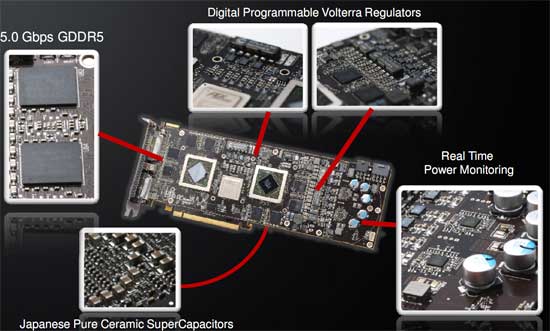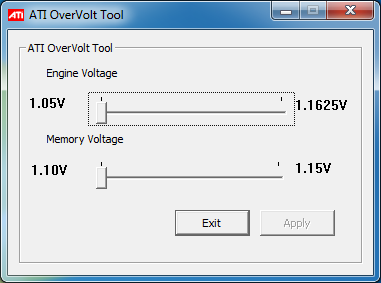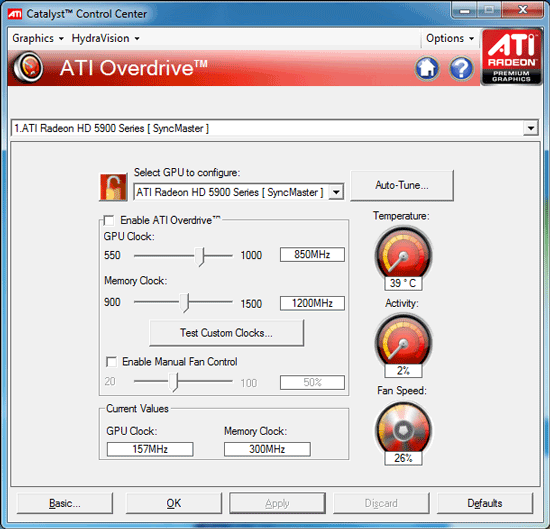The Radeon HD 5970: Completing AMD's Takeover of the High End GPU Market
by Ryan Smith on November 18, 2009 12:00 AM EST- Posted in
- GPUs
The Card They Beg You to Overclock
As AMD equipped 5970 with a fully functional Cypress core, one particularly binned for its excellent performance, it’s a shame the 5970 is only clocked at 725MHz core, right? AMD agrees, and has equipped and will be promoting the 5970 in a manner unlike any previous AMD video card.
Officially, AMD and its vendors can only sell a card that consumes up to 300W of power. That’s all the ATX spec allows for; anything else would mean they would be selling a non-compliant card. AMD would love to sell a more powerful card, but between breaking the spec and the prospect of running off users who don’t have an appropriate power supply (more on this later), they can’t.
But there’s nothing in the rulebook about building a more powerful card, and simply selling it at a low enough speed that it’s not breaking the spec. This is what AMD has done.
As a 300W TDP card, the 5970 is entirely overbuilt. The vapor chamber cooling system is built to dissipate 400W, and the card is equipped entirely with high-end electronics components, including solid caps and high-end VRMs.

Make no mistake: this card was designed to be a single-card 5870CF solution; AMD just can’t sell it like that. In our discussions with them they nearly (as much as Legal would let them) promised that every card will be able to hit 850MHz core (after all, these chips are binned to be better than a 5870), and memory speeds were nearly as optimistic, although we were given the impression that AMD is a little more concerned about GDDR5 memory bus issues at 5870 speeds.
So with the card that is a pair of 5870s in everything except the shipping specifications, AMD has gone ahead and left it up to the user to put 2 + 2 together, and to bring the card to its full potential. The card ships with a much higher Overdrive cap than AMD’s other cards; instead of 10-20%, here the caps are 1GHz for the core and 1.5GHz for the memory, a 37% and 50% cap respectively (in comparison, on the 5850, the caps were set below the 5870’s stock speeds). The card effectively has unlimited overclocking headroom within Overdrive; we doubt that any 5970 is going to hit those speeds with air cooling.
One weakness of Overdrive is that it doesn’t let you tweak voltages, which is a problem since AMD has to ship this card at lower voltages in order to meet the 294W TDP. In order to rectify that, AMD will be supplying vendors with a voltage tweaking tool specifically for the 5970, which will then be customized and distributed by vendors to their 5970 users.
Normally any kind of voltage tweaking on a video card makes us nervous due to the lack of guidance – a single GPUs doesn’t ship at a wide range of voltages after all. For overvolting the 5970, AMD has made matters quite simple: you only get one choice. The utility we’re using offers two voltages for the core, and two for the memory, which are the shipping voltages and the voltages the 5870 runs at. So you can run your 5970 at 1.05v core or 1.165v core, but nothing higher and nothing in between. It makes matters simple, and locks out the ability to supply the core with more voltage than it can handle. We haven’t seen any of the vendor-customized versions of the Overvolt utility, but we’d expect all of them to have the same cap, if not the same two-setting limit.


All of this comes at a cost however: power. Cranking up the voltage in particular will drive the power draw of the card way up, and this is the point where the card ceases to meet the PCIe specification. If you want to overclock this card, you’re going to need not just a strong power supply that can deliver its rated wattage, but you’re going to need a power supply that can overdeliver on the rails attached to the PCIe power plugs.
For overclocked operation, AMD is recommending a 750W power supply, capable of delivering at least 20A on the rail the 8pin plug is fed from, and another 15A on the rail the 6pin plug is fed from. There are a number of power supplies that can do this, but you need to pay very close attention to what your power supply can do. Frankly we’re just waiting for a sob-story where this card cooks a power supply when overvolted. Overclocking the 5970 will bring the power draw out of spec, its imperative you make sure you have a power supply that can handle it.
Overall the whole issue leaves us with an odd taste in our mouths. Clearly AMD would have rewritten the ATX spec to allow for more power if it were that simple, and we don’t believe anyone really wants to be selling a card that runs out of spec like this. Both AMD and NVIDIA are going to have to cope with the fact that power draw has been increasing on their cards over time, so this isn’t going to be the last over-300W card we see. I would not be surprised if we saw a newer revision of the ATX spec that allowed for more power for video cards – if you can cool 400W, then that’s where the new maximum is going to be for luxury video cards like the 5970.
Last, but certainly not least, there’s the matter of real-world testing. Although AMD told us that the 5970 should be able to hit 5870 clockspeeds, we actually didn’t have the kind of luck we were expecting to have. We have 2 5970s,one for myself, and one for Anand for Eyefinity and power/noise/heat testing. My 5970 hit 850MHz/1200MHz once overvolted (it had very little headroom without it), but the performance was sporadic. The VRM overcurrent protection mechanism started kicking in and momentarily throttling the card down to 550MHz/1000MHz, and not just in FurMark/OCCT. Running a real application (the Distributed.net RC5-72 Stream client) ultimately resulted in the same thing. With the core overvolted, our card kept throttling on FurMark all the way down to 730MHz. While the card is stable in terms of not crashing, or verdict is that our card is not capable of performing at 5870 clockspeeds.
We’ve attempted to isolate the cause of this, and we feel we can rule out temperature after feeding the card cold morning air had no effect. This leaves us with power. The power supply we use is a Corsair 850TX, which has a single 12V rail rated for 70A. We do not believe that the issue is the power supply, but we don’t have another unit on hand to test with, so we can not eliminate it. Our best guess is that in spite of the high-quality VRMs that are on this card, that they simply aren’t up to the task of powering the card at 5870 speeds and voltages.
We’ve gone ahead and done our testing at these speeds anyhow (since overcurrent protection doesn’t cause any quality issues), however it’s likely that these results are retarded somewhat by throttling, and that a card that can avoid throttling would perform slightly better. We're going to be retesting this card in the morning with some late suggestions from AMD (mainly forcing the fan to 100%) to see if this changes things, but we are fairly confident right now that it's not heat related.
As for Anand's card, his fared even worse. His card locked up his rig when trying to run OCCT at 5870 speeds. VRM throttling is one thing, but crashing is another; even if it's OCCT, it shouldn't be happening. We've written his card off as being unstable at 5870 speeds, which makes us 0-for-2 in chasing the 5870CF. Reality is currently in conflict with AMD's promises.
Note: We have since published an addendum blog covering VRM temperatures, the culprit for our throttling issues










114 Comments
View All Comments
palladium - Wednesday, November 18, 2009 - link
Since AMD is binning their chips to get the 5970 within spec, I suppose it wouldn't make sense to make a 5950 SKU since a 5850 is simply a re-harvested 5870 (which failed the initial binning process), and 2x5850 would be out of the ATX spec anyway.Anyway, a great card for those who can afford it, and have the proper case and PSU to handle it.
Paladin1211 - Wednesday, November 18, 2009 - link
With 512 SP, 6.67% more than a GTX 295, I dont see Fermi has any chance of beating the 5970. nVidia will need a dual Fermi to dethrone the 5970, and thats not happening until Q3 or Q4 2010.nVidia has targeted a wrong, niche market rather than gamers. Sooner or later monitors without bezel will come out, and Eyefinity makes much more sense. Its really funny that the R770s aka HD 4870s are in 1 out of 5 fastest supercomputers and not Tesla.
They have taken a long, deep sleep after the 8800GTX and now they're paying for it.
cmdrdredd - Wednesday, November 18, 2009 - link
Unfortunately, PC gaming is almost dead. Look at Call of Duty's release. Look at Dragon Age which is also available on consoles. Sure the PC version might look a bit better, but when you spend as much on a video card as someone does on an entire system that can download movies, demos, act as a media box, and play Blu-Rays...you get the point.Lurker0 - Wednesday, November 18, 2009 - link
Unfortunately, PC gaming has been declared "nearly dead" for decades. It hasn't died, and as much as console fanboys will rage on hearing this, it isn't going to either.PC gaming is a niche industry, it always has been and always will be. Yes, console games do tend to be more profitable, which means that most games will be developed for consoles first and then ported to the PC. Doesn't mean there will never be games developed for the PC first(or even exclusivly), or that there's no profit to be had in PC games.
Yes, it can be cheaper to get a console than a mid-level gaming PC, just like it can be cheaper to just buy some econobox off the lot than to buy or build your own hot rod. Sure, one market is much larger and more profitable than the other, but there's still money to be made off of PC games and gearheads alike, and so long as that's true neither will be going away.
DominionSeraph - Thursday, November 19, 2009 - link
PC gaming is no longer an isolated economy, though. That changes things. With most games being written with consoles in mind, there isn't the broad-based software push for hardware advance that there was at the dawn of 3d acceleration.I could give you dozens of great reasons to have upgraded from a NV4 to a NV15 back in the day, but the upgrade from a G80 to 5970 today? ~$800 when you factor in the PSU, and for what? Where's the must-have game that needs it? TNT to Geforce 2 was two years -- it's now been 3 since the release of the 8800, and there's been no equivalent to a Half Life, Quake 2, Deus Ex, Homeworld, Warcraft III, or WoW.
GourdFreeMan - Thursday, November 19, 2009 - link
Unfortunately, this is precisely the problem. When looking at AAA (large budget) games, six years ago PC game sales were predominantly PC exclusives, with some well known console ports (e.g. Halo, Morrowind). Twelve years ago PC game sales were almost entirely exclusives. Today the console ports are approaching the majority of high profile PC titles.Being multiplatform isn't necessarily a detriment for a console game. After all, having a larger budget allows more money to be spent on art and polishing the code to get the best performance on console hardware. In most cases, however, the PC version of a multiplatform title is almost always an afterthought. Little to no effort is spent redesigning the user interface and rebalancing game play because of the different controls. Shaders are almost never rewritten to take advantage of effects that could only be accomplished with the power of the graphic cards in modern PCs when porting. At most we seem to get better textures at somewhat higher resolutions.
The biggest problem with multiplatform development, however, is that multiplatform games are almost always aimed at the lowest common denominator in terms of both technology and content. All this does is produce the same game over and over again -- the clichéd rail shooter in a narrow environment with a macho/reluctant superhuman protagonist thrown against hordes of respawning mooks.
Based on the quarterly reports of sales revenue from the major publishers (EA, Activision and Ubisoft), PC games sales are comparable to PS3 game sales. The PS3, however, has several more exclusives because Sony owns several games studios and forces them to release exclusives. AMD and nVIDIA do not, much to PC gaming's detriment.
mschira - Wednesday, November 18, 2009 - link
Hehe 5970CF to power three screens, now that sounds like a killer setup.Besides that one's burning 600+ watts for the graphic. What's the CPU supposed to live on? The BIOS-Battery?
M.
monomer - Wednesday, November 18, 2009 - link
Wouldn't it be possible to run six screens using a 5970 CF setup, or are there other limitations I'm unaware of?Fleeb - Wednesday, November 18, 2009 - link
600W for the whole setup. :Smaximusursus - Wednesday, November 18, 2009 - link
It really seems weird...:( I've seen some reviews that had way better overclocking than the standard 5870 clocks and their tests seem to be ok without any "throttling" problems.For example:
Techspot: 900/1250
HotHardware: 860/1220
Tom's Hardware: 900/1300
HardOCP: 900/1350 (!)
Guru3D: 900/1200
HardwareZone however had a similar problem with you guys, could it really be the PSU?